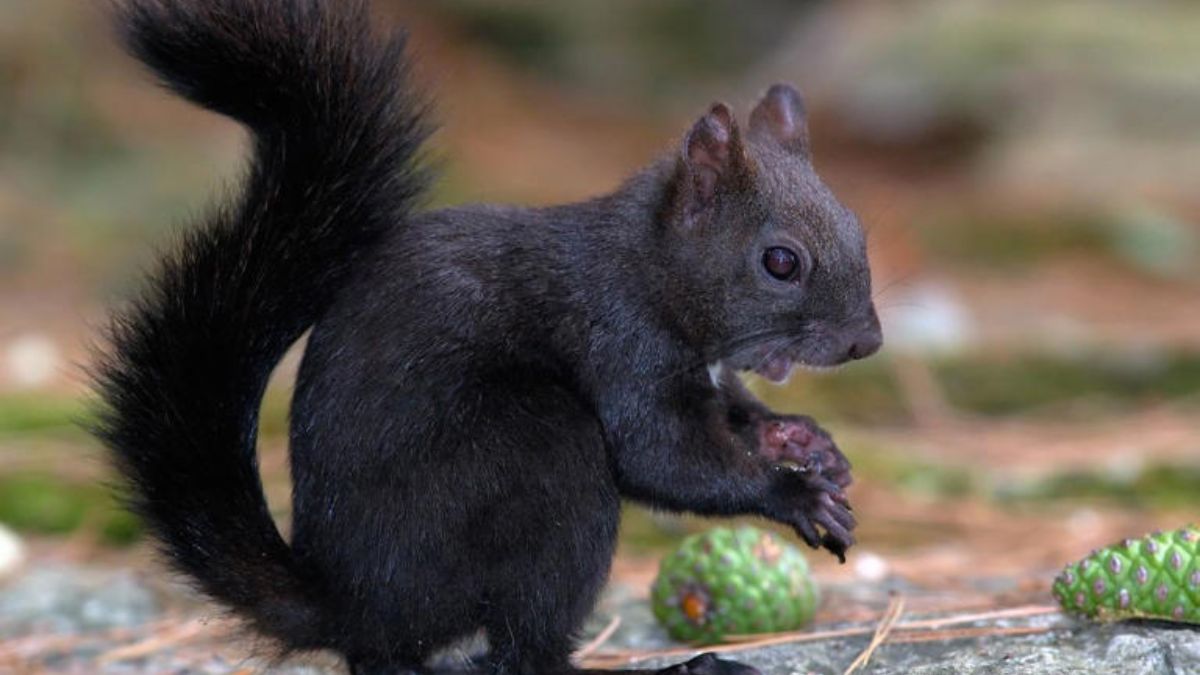HOME
The Mystique of the Black Squirrel: Nature’s Little Shadow

In the world of wildlife, few creatures capture our imagination quite like the black squirrel. With their sleek ebony coats and playful antics, these small mammals dart through parks and backyards, often unnoticed among their more common gray counterparts. A symbol of mystery and intrigue, black squirrels have a unique charm that begs to be explored. But what makes them so special? Join us as we delve into the fascinating life of the black squirrel—nature’s little shadow—and discover why they deserve a spotlight in our hearts and ecosystems alike. Whether you’re an animal enthusiast or simply curious about your local wildlife, there’s much to uncover about these captivating critters.
The science behind black fur
The black fur of a black squirrel is more than just an aesthetic trait. It results from a genetic variation that produces excess melanin, the pigment responsible for coloration in many animals.
This dark hue offers multiple advantages. It provides better camouflage in certain environments, allowing them to blend into the shadows and evade predators. The dense fur also helps with thermoregulation during colder months.
Research shows that darker-colored squirrels tend to thrive in urban areas where their natural habitats are altered. Their adaptability showcases nature’s ingenuity, as they respond to changing landscapes while maintaining their unique charm.
Interestingly, this color variation isn’t exclusive to squirrels; other animals like foxes and crows exhibit similar traits. Each creature harnesses its external appearance as a survival tactic tailored by evolution over time.
Historical significance and myths surrounding black squirrels
Black squirrels have long been woven into the tapestry of folklore and cultural narratives. Many Native American tribes viewed them as symbols of good luck or prosperity, often featuring them in stories passed down through generations.
In some regions, black squirrels were thought to be harbingers of storms. Their sudden abundance was said to signal a harsh winter ahead. This belief reflects humanity’s deep connection with nature and its creatures.
Moreover, black fur has sparked numerous myths about transformation. Some cultures believed that these enigmatic animals could shift between worlds, embodying both shadow and light.
As urban legends go, sightings of all-black squirrels sometimes marked significant events or changes within communities. Their presence invoked curiosity and wonder among those who encountered them in parks or backyards.
These fascinating beliefs highlight the enduring intrigue surrounding black squirrels throughout history—an allure still felt today.
Black squirrel population and distribution
The black squirrel, a striking variant of the common gray squirrel, is found predominantly in North America. Their population thrives in both urban and suburban environments, where they adapt well to human presence.
These squirrels are particularly prevalent in regions with deciduous forests. States like Michigan and Ohio boast notable black squirrel communities. Interestingly, their distribution is not uniform; some areas have higher concentrations thanks to genetic factors and local climate.
Urban settings provide ample food sources and nesting opportunities, contributing to their growing numbers. However, rural habitats also support healthy populations that flourish amidst natural landscapes.
Black squirrels have also made their way into parts of Canada and even some European countries due to introductions over time. This adaptability highlights how these creatures can navigate different ecosystems while maintaining their unique charm.
Unique behaviors and adaptations of black squirrels
Black squirrels are not just striking in appearance; they exhibit fascinating behaviors that set them apart from their gray cousins. One notable adaptation is their ability to thrive in urban environments. These clever critters have learned to navigate city landscapes, foraging for food and making nests in parks and residential areas.
Their diet showcases remarkable versatility. Black squirrels will eat nuts, seeds, fruits, and even fungi. They often bury food to store it for winter months, which helps with seed dispersal—an essential process for forest regeneration.
Communication also plays a key role in their behavior. Black squirrels use a range of vocalizations and body language to express alarm or attract mates. Their agility allows them to leap between branches effortlessly while avoiding predators like hawks or cats.
These unique traits contribute significantly to the adaptability of black squirrels, allowing them to flourish where other species might struggle.
Why black squirrels are important for ecosystems
Black squirrels play a crucial role in their ecosystems. As foragers, they help disperse seeds and nuts across vast areas. This behavior promotes plant growth and biodiversity.
Their unique feeding habits contribute to forest regeneration. By burying food, black squirrels inadvertently create new plants when they forget about some of their stash. This natural sowing process supports various flora species.
Moreover, as prey animals, black squirrels are vital in the food chain. They provide sustenance for predators like hawks, foxes, and owls. Their presence indicates a healthy ecosystem where predator-prey dynamics are balanced.
Additionally, black squirrels can adapt to urban environments. Their ability to thrive alongside humans showcases nature’s resilience while fostering ecological connections within communities.
By understanding their importance in ecosystems, we recognize the need to protect these fascinating creatures and the habitats they inhabit.
Conservation efforts and challenges facing black squirrels
Conservation efforts for black squirrels are crucial, yet they face several challenges. Habitat loss remains a significant threat as urbanization encroaches on their natural environments. Parks and green spaces can provide refuge, but these areas often become fragmented.
Moreover, climate change impacts food availability and alters habitats. As temperatures rise, the ecosystems that sustain black squirrels may shift dramatically, making survival more difficult.
Local wildlife organizations have initiated programs to monitor populations and promote awareness about the importance of preserving their habitats. Education is key; communities need to understand how vital these creatures are to local ecosystems.
Additionally, genetic diversity among black squirrel populations is another pressing concern. Limited breeding opportunities can lead to weakened resilience against diseases or environmental changes.
With collaborative conservation efforts and community involvement, there’s hope for sustaining this enigmatic species in our ever-evolving world.
Fun facts about black squirrels
Black squirrels are fascinating creatures with some intriguing traits. Did you know they can leap up to 10 times their body length? This incredible agility helps them navigate trees and evade predators.
These little acrobats also have a unique communication system. They use various sounds, including chirps and growls, to convey different messages. It’s like their own secret language!
Interestingly, black squirrels are not a separate species but rather a color variation of the eastern gray squirrel. Their striking fur is due to higher levels of melanin, which provides better camouflage in certain environments.
In some regions, black squirrels have become quite the local celebrity! People often go out of their way just to catch a glimpse of these charming animals as they scamper about parks and neighborhoods.
Did you know that black squirrels contribute significantly to forest ecology by planting seeds? As they bury nuts for winter storage, many end up sprouting into new trees.
Conclusion: Why we should appreciate the mystique of the black squirrel
The black squirrel remains a fascinating creature that sparks curiosity and admiration. Its striking appearance sets it apart in the animal kingdom, capturing our attention as it scurries through parks and backyards. Beyond its enigmatic look lies a wealth of scientific intrigue, rich history, and ecological significance.
These creatures play crucial roles in their ecosystems by aiding in seed dispersal and contributing to plant diversity. Their unique adaptations allow them to thrive in various environments, showcasing nature’s ability to innovate. Despite facing challenges like habitat loss, conservation efforts are underway to ensure these remarkable animals continue to exist alongside us.
As we learn more about black squirrels—their behaviors, myths surrounding them, and their importance—we can foster greater appreciation for this little shadow of nature. Observing them not only enriches our outdoor experiences but also reminds us of the intricate web of life that sustains our world. By cherishing the mystique of the black squirrel, we embrace a deeper connection with wildlife around us.
HOME
Key Considerations When Planning a Commercial Construction Project

Commercial construction projects require careful planning, as each decision made in the early stages can impact the project’s success far into the future. Whether you are breaking ground on a retail space, office complex, or pursuing commercial rebuilds Maryland, it’s essential to balance vision with strategy from day one. The steps you take before construction begins are often the most influential, affecting everything from costs and timelines to occupant satisfaction.
By addressing critical elements such as budgeting, scheduling, team selection, and compliance with regulations, you can improve the likelihood of delivering a project that meets both business goals and stakeholder expectations. Considering environmental impact, future adaptability, and a collaborative approach will also help ensure the property’s long-term value and reputation.
Commercial construction projects can be particularly complex, involving multiple stakeholders, tight deadlines, and substantial financial investment. Proactive planning and a holistic viewpoint can make the difference between a project that flounders and one that exceeds expectations. According to Forbes, strategic foresight and flexibility are crucial to overcoming the numerous challenges prevalent in today’s construction environment.
Establish a Realistic Budget and Timeline
Your construction budget is more than just a list of costs—it’s a dynamic document that guides the entire project. Begin by accounting for materials, labor, permits, fees, and contingencies for unforeseen events such as market fluctuations or adverse weather. Allocating a contingency fund of 5-10% is a prudent move that allows projects to weather unexpected costs without jeopardizing completion.
Crafting a realistic timeline is equally essential. Take the time to assess how external factors, such as supply chain complications or regulatory holdups, may introduce delays. Regular progress reviews and built-in schedule buffers help maintain momentum, making it easier to adapt should delays arise.
Assemble a Competent Project Team
Success in commercial construction hinges on the expertise brought by your team. Select reputable architects, engineers, contractors, and specialists whose experience aligns with your project’s complexity. Equally important is fostering a collaborative environment that encourages open communication, as this helps reduce misinterpretations and mistakes that could inflate budgets or extend timelines.
Formalizing roles and responsibilities and holding regular coordination meetings will keep everyone aligned and efficiently move the project forward. As highlighted by Construction Dive, frequent communication and clearly defined processes are proven to reduce costly rework and boost productivity.
Understand Zoning Laws and Obtain Necessary Permits
Before launching construction, ensure compliance with all relevant zoning laws and secure the necessary permits. Local government regulations vary and may restrict aspects of your design, use of the property, or even the materials allowed. Early engagement with municipal authorities can reveal unexpected requirements and help prevent violations that lead to fines or costly design changes midway through the project.
Prioritize Functionality and Design
The balance of visual appeal and practical utility is central to a successful commercial space. Consider how layout decisions will support everyday operations, accessibility, and occupant comfort. Factors such as lighting, acoustics, and spatial flexibility can drastically impact productivity and make a property more attractive to tenants or clients. Integrating features for ADA compliance ensures inclusivity and maximizes usability.
Incorporate Sustainability and Energy Efficiency
Sustainable building practices reduce long-term operational costs and environmental impact. Implementing measures like high-efficiency HVAC systems, low-flow fixtures, LED lighting, and solar panels reflects a commitment to green building, which can also attract tenants seeking environmentally conscious workspaces. Utilizing recycled materials and pursuing certifications like LEED can enhance market appeal and demonstrate broader corporate responsibility.
Achieving energy efficiency is not only an investment in the planet, but it can also result in utility incentives or rebates, thereby reducing overall expenditures. As detailed by the U.S. Environmental Protection Agency, integrating lifecycle thinking into construction helps promote sustainability in every phase of the project.
Plan for Future Growth and Flexibility
Design flexibility enables a commercial property to adapt as business requirements evolve or market conditions shift. Versatile spaces, modular walls, and adaptable utility systems make it easy to reconfigure workplaces or expand with minimal disruption. This future-resilient approach not only supports organic growth but can prolong the viability of a building for new uses over time.
Ensure Quality Control and Safety Measures
Quality assurance begins before ground is broken and continues throughout the construction process. Implement standardized best practices for inspections and testing, and monitor for alignment with project specifications and safety codes. Enforcing occupational health and safety standards, conducting regular training, and maintaining transparent channels for workers to report issues help protect both people and the project’s reputation. The Occupational Safety and Health Administration (OSHA) provides valuable resources for maintaining industry safety standards.
Engage with the Community
Proactive engagement with neighboring communities can accelerate project approvals and foster goodwill. Hosting public input sessions or updating stakeholders through local news channels demonstrates commitment to positive relationships and social responsibility. Collecting and responding to feedback helps mitigate concerns and encourages project acceptance, reducing potential friction with local stakeholders.
Final Thoughts
Successful commercial construction projects are rooted in thoughtful planning, regulatory diligence, and ongoing collaboration. By considering each essential factor—from budgeting and personnel to sustainability and community engagement—you can deliver outcomes that withstand today’s challenges while preparing for tomorrow’s possibilities.
HOME
Creative Ways to Build Safer Horse Jumps for All Riders

Horse jumping is a thrilling equestrian sport that combines athleticism, agility, and trust between horse and rider. However, with the excitement comes a certain degree of risk, which makes safety an essential factor to consider every time a horse and rider enter the arena or take on a new course. Over the years, the introduction of innovative materials and modern safety features has significantly contributed to transforming training spaces into more secure environments, all while maintaining the challenging spirit these jumps are meant to foster. For riders, trainers, and stable owners considering the addition of new horse jump designs—especially those seeking to strike a balance between exhilaration and well-being—it’s vital to understand the most effective construction methods available today. The right approach can keep both horses and humans safe, minimizing the likelihood of injury and supporting long-term participation in the sport.
By leveraging creative building techniques and selecting suitable materials, it’s possible to prevent many of the common injuries and accidents often associated with traditional horse jumps. These strategies not only prioritize safety but also frequently reduce overall costs by utilizing readily available and affordable resources. Additionally, many of these methods promote sustainability by reusing or repurposing everyday items, which is an increasing concern in contemporary equestrian practice. Whether you are a professional trainer responsible for a bustling academy or a passionate DIY enthusiast constructing obstacles in your own backyard, the commitment to building safer jumps is a significant contribution to a broader culture of responsible and sustainable equestrianism. In turn, this encourages inclusivity and lifelong enjoyment for riders at every level, from those just starting to those mastering advanced courses.
Utilizing Plastic Barrels for Versatile Jump Designs
Plastic barrels offer a practical and innovative alternative to traditional jump wings and fillers, providing excellent strength, weather resistance, and versatility at a fraction of the expense of commercial materials. Filled with sand or water, these sturdy barrels remain in place even when horses brush past or knock them, ensuring stability during use. Their surfaces can be easily cleaned, which helps reduce risks associated with slippery or dirty setups. Jump cups explicitly designed for barrel use are readily available. They can be attached directly to the sides, ensuring that jump rails are securely held but can dislodge safely in the event of force. This method enables quick and frequent course modifications, allowing for easy tailoring of exercises to individual horses and riders, and for enhancing the training routine without the need for multiple sets of heavy equipment. The flexibility plastic barrels provide is key for instructors working with students of diverse skills and confidence levels. To gain more insight on effective, budget-friendly materials and straightforward construction methods, have a look at the tips from Horse & Hound.
Repurposing Wooden Pallets for Customizable Jumps
When it comes to resourcefulness and sustainability, wooden pallets stand out as one of the best materials for building horse jumps. Readily available from warehouses, stores, or community giveaways, these pallets can easily be transformed into jump standards, gates, or fillers. Before integrating a pallet into your jump, a thorough safety check is crucial—ensure that all nails, loose boards, and potential splinters are removed. Sanding down any rough edges significantly minimizes injury risk for both horse and rider. Once prepped, wooden pallets can be customized for specific courses or themes: painting them with bright, horse-safe colors or adding weather-resistant decorations increases their visibility and attractiveness, keeping both horses and riders engaged and alert. Furthermore, since pallets can be easily reconstructed or combined, they allow the creation of jumps with varying heights, widths, and complexity; this flexibility is particularly valuable for accommodating a range of skill levels and promoting gradual, safe progression in training routines.
Incorporating Rounded Edges and Collapsible Components
Paying attention to the finer details of construction can make a significant difference in safety outcomes. Jumps with sharp or pointed corners have historically caused injuries when horses graze or knock against them. By intentionally designing jump elements with rounded edges—either by sanding wood, using PVC piping, or fitting protective edge covers—you greatly reduce the likelihood of cuts, bruises, or more serious trauma. Even more impactful are collapsible components, such as breakaway cups, which are engineered to release their contents upon significant impact rather than remaining rigid. This “give” can help prevent falls or entanglement and is especially important when working with green horses or novice riders. Collapsible features are now commonly found in modern jumping equipment, particularly for cross-country and eventing, where obstacles often require a solid-looking yet safer construction. For a look at the latest developments in jump safety and construction techniques, check out The Chronicle of the Horse for articles and updates from leading industry experts.
Implementing Frangible Pins for Enhanced Safety
One of the most significant safety advances in recent years has been the widespread adoption of frangible pins in competitive horse jumping. These specialized pins are engineered to break or collapse under the weight or force of a horse hitting a jump, causing potentially dangerous solid elements to fall away harmlessly. This dramatically reduces the risk of a rotational fall, which is one of the most serious types of accidents in jumping disciplines, especially eventing. The use of frangible technology is now considered best practice for permanent jumps and is increasingly being adopted by safety-focused facilities and competitions. By integrating frangible pins, builders create an extra layer of safety that can mean the difference between a close call and a catastrophic injury. For a closer look at how frangible pins and innovative safety systems are making an impact, the United States Eventing Association provides guidelines, technical documents, and real-world case studies to help builders and trainers effectively apply these concepts.
Regular Maintenance and Inspection of Jumps
Safety is not just a matter of initial construction but ongoing diligence. Even the best-designed jumps lose their integrity over time due to exposure to weather, repeated use, or accidental knocks. Establishing a regular maintenance and inspection routine is key to ongoing safety. Take the time to examine all surfaces for loose parts, worn areas, or sharp protrusions. Wooden jumps should be resealed or repainted with non-toxic, weather-resistant products to ensure they withstand rain and sun exposure without becoming brittle or splintered. Metal components must be inspected for signs of rust, fatigue, and loose connections. This commitment to upkeep helps maintain confidence among riders and horses alike and protects the investment made in equipment by extending its usable life.
Customizing Jumps to Suit Various Skill Levels
One significant advantage of modern DIY or custom-built jumps is adaptability. Adjustable and modular designs empower trainers and riders to alter jump height, width, and challenge quickly; stackable fillers, sliding or removable jump cups, and interchangeable decorative panels make these adjustments both safe and straightforward. This adaptability is indispensable in lesson programs, clinics, or any setting serving a range of ages and abilities. Starting with lower, less complex jumps helps foster confidence in new riders and green horses, while more experienced jumpers can be safely challenged with higher, wider, or uniquely configured obstacles. The ability to fine-tune jumps as skills progress supports steady learning and tailors the risk to the rider’s level. For creative ideas on bringing modular designs to your arena or field, inspiration is only a click away—publications like Horse Illustrated frequently feature projects for all experience levels.
Conclusion
Building safer horse jumps is far more than simply assembling obstacles—it’s a thoughtful process that must balance creativity, responsibility, and practicality. By using accessible, budget-friendly materials, incorporating advanced safety features, customizing designs for all ability levels, and maintaining a commitment to ongoing upkeep, trainers and riders can create a safe and dynamic training space that fosters progress and enjoyment. Ultimately, these innovations enrich the equestrian experience and help ensure that both horses and their riders can confidently pursue their sport for years to come.
HOME
Effective Non-Surgical Strategies for Managing Chronic Pain

Chronic pain is a significant and persistent issue affecting millions of people worldwide, disrupting daily activities, work productivity, and overall well-being. While surgical intervention is sometimes considered, many individuals seek relief through safer, non-invasive methods to manage pain and improve quality of life. Early collaboration with healthcare experts and specialized clinics, such as a pain management clinic St Augustine, FL, can offer tailored guidance on proven non-surgical approaches that empower you to take control of your pain journey.
Chronic pain management benefits most from a holistic, multi-faceted approach that combines physical rehabilitation, alternative therapies, lifestyle changes, and modern medical advancements. This patient-centered strategy addresses both physical and emotional aspects of pain, helping reduce reliance on medication and avoid invasive procedures. Staying informed about evidence-based treatments empowers individuals to make informed decisions and achieve long-term relief, while also improving their daily functioning.
Physical Therapy
Physical therapy remains one of the most recommended and effective non-surgical solutions for managing chronic pain. A trained physical therapist can identify mobility issues, muscular imbalances, and movement patterns that may contribute to ongoing discomfort. Through a combination of manual therapy, stretching, strengthening exercises, and functional movement training, patients often experience long-term pain reduction, increased flexibility, better balance, and a decreased risk of reinjury. The benefits extend beyond symptom relief to empower individuals with the knowledge and tools to protect their bodies during everyday activities.
Alternative Therapies
Alternative and complementary therapies have gained immense popularity as people seek holistic options for pain control. Practices such as acupuncture utilize fine needles to stimulate the body’s nerves and muscles, prompting the release of natural painkillers. Chiropractic care addresses mechanical dysfunctions—especially in the spine—that might aggravate pain, while massage therapy promotes relaxation, relieves muscle tightness, and increases circulation. Many patients report reduced reliance on conventional pain medications thanks to these integrative approaches, which can enhance overall treatment effectiveness when combined with physical therapy or medical management.
Mindfulness and Cognitive Behavioral Therapy
The psychological impact of chronic pain cannot be underestimated. Mindfulness techniques, notably mindfulness-based stress reduction (MBSR) and cognitive behavioral therapy (CBT), provide valuable methods for managing pain perception and emotional responses. These therapies guide individuals in recognizing pain triggers, challenging negative thought patterns, and building resilience through healthy coping strategies. Research has shown that incorporating mindfulness and CBT can significantly decrease pain intensity, improve sleep quality, and reduce the risk of depression and anxiety associated with chronic pain.
Lifestyle Modifications
Adopting practical lifestyle changes is a cornerstone of sustainable, non-surgical pain relief. Regular physical activity, tailored to an individual’s limitations and capabilities, helps maintain joint and muscle health and improves pain tolerance over time. Mind-body practices, such as yoga and tai chi, can increase flexibility, foster relaxation, and combat stress, thereby reducing pain experiences. Maintaining a balanced diet—rich in anti-inflammatory foods such as leafy greens, berries, fatty fish, and nuts—can contribute to overall well-being. Adequate, restorative sleep is especially crucial, as poor sleep can intensify pain sensitivity.
Furthermore, achieving and maintaining a healthy weight can greatly ease the burden on weight-bearing joints, particularly for individuals with arthritis or lower back pain.
Emerging Treatments
Innovation in non-surgical pain management has led to the development of exciting new therapies. VER-01, a cannabis-derived medication, has demonstrated superior pain control with fewer side effects in clinical studies among patients suffering from chronic lower back pain, when compared to both placebos and opioids. Patients using VER-01 reported not only pain relief but also better sleep and an overall improvement in daily functioning.
Another promising option is low-dose radiotherapy, which, though traditionally used for cancer, has been shown in recent trials to safely and effectively reduce pain from mild-to-moderate osteoarthritis. Clinical results revealed a significant number of patients experienced meaningful pain relief and functional improvement, particularly in the knees, following this low-risk treatment.
Conclusion
Managing chronic pain effectively does not always require surgery. By integrating physical rehabilitation, alternative therapies, mindfulness, healthy lifestyle habits, and the latest medical innovations, individuals can find substantial relief and regain functionality. Collaborating with a qualified pain specialist or dedicated pain management clinic ensures that each strategy is personalized, improving the likelihood of long-term success. As new research and treatments continue to emerge, the outlook for those living with chronic pain grows brighter, offering hope for an active, fulfilling life beyond persistent discomfort.
-

 FASHION10 months ago
FASHION10 months agoTop Kids Clothing Trends for 2025 – What’s In Style This Year?
-

 FASHION1 year ago
FASHION1 year agoElegant Winter Party Style: Trendy Long-Sleeve Dresses and Essential Hair Care Tips
-

 AUTOMOTIVE11 months ago
AUTOMOTIVE11 months agoMitsubishi Pajero 3.0 V6 – Specs, Performance & Guide
-

 BUSINESS1 year ago
BUSINESS1 year agoHOW TO SHOP GOODWILL OUTLET STORE
-

 HOME10 months ago
HOME10 months agoTributePrintedPics Review: A Deep Dive into Quality, Design, and Customer Experience
-

 CULTURE10 months ago
CULTURE10 months agoUncuymaza Unveiled: The Cultural Significance Behind the Craft
-

 LIFESTYLE10 months ago
LIFESTYLE10 months agoDiscovering Luuxly.com: Your Ultimate Guide to Luxury Lifestyle
-

 HOME11 months ago
HOME11 months agoExploring the World of TG Tube: A Comprehensive Guide
